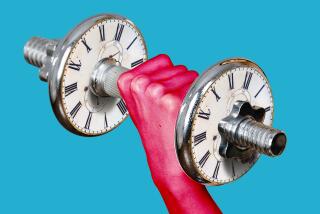High-Impact Exercise Is the Best Prevention
- Share via
If new research bears out, then dusting off that old step aerobics step--and jumping on and off it--may become the next exercise craze. Or perhaps walking up the stairs to work, wearing a backpack.
These high-impact exercises reflect the latest thinking on the kind of activities that can help prevent, slow or possibly reverse the effects of osteoporosis, the often debilitating bone disease.
Some 20 million American women already have osteoporosis. And although the disease is often thought of as afflicting primarily women, an estimated 7 million to 12 million men also have osteoporosis. In fact, the risk of a man developing osteoporosis is greater than his risk of getting prostate cancer.
For those at risk of osteoporosis, some of the most exciting discoveries concern the role exercise can play.
During the past century, health promotion specialists have recommended weight-bearing exercise for increasing bone mass. They recommended walking and hiking, for example, as preferable to swimming because of the “load” placed on the bone.
Most of these theories were developed before better technologies for measuring bone density with much greater accuracy became widely available during the past decade. With new scanning devices such as DEXA (dual energy X-ray absorptiometry), researchers are now finding that, in middle age, weight-bearing exercise alone is not enough.
*
Exercise can influence bone development only up to about age 24. After that, exercise yields only slight increases in bone mass. A year of regular exercise has been shown to increase bone mass by only 1%, after which such benefits cease.
Still, advertisements touting exercise as a way around osteoporosis aren’t all wrong. Exercise can increase muscle strength, coordination and balance--all very protective in preventing the serious injuries of osteoporosis like hip and spine fractures. And there is increasing evidence that exercise may slow bone loss.
By varying their exercises, people can influence how the bone responds and perhaps, in some instances, increase bone mass.
Certain exercises now are being credited with slowing the removal of old bone and stimulating new bone formation.
Studies have shown, for example, that people who engage in impact sports like gymnastics have greater bone mass than lower-impact athletes like swimmers and runners. Even middle-aged and older men and women have increased their bone mass in response to high-impact exercises: running is better than walking; jumping rope is better than golfing.
Not that swimmers lose out. The muscle contractions of swimming provide a different load on bone, and this too has been shown to help retain bone mass. A similar benefit can be gained through strength training: when you lift weights with your legs, for example, it causes muscles to contract and the load on the bone is greater than when you simply walk. As you use your muscle, some as-yet-unknown factor stimulates the bone and represses resorption. The effect appears to be greater when you are lowering a weight rather than lifting it.
*
Preliminary research suggests that creating pressures that the bone is not already used to helps increase bone formation. This makes cross training, where a lot of different stresses take place, far more appealing. It suggests an exercise program that includes some type of aerobic impact exercise, plus strength and flexibility exercises and weight training.
All of these exercises must be approached cautiously by people who have been diagnosed with osteoporosis. Many exercises are not recommended, such as stooping exercises (picking up something off the floor), which flex the spine excessively and can lead to fractures. And balance, flexibility and strength exercises should be performed in a safe manner, either with spotting by a trainer or holding on to an object such as a bar.
Researchers may eventually agree on an exercise regimen that protects against bone loss and perhaps increases skeletal mass. Such a program is years away, however. What is clear is that the earlier you initiate an exercise program, the better off you will be. Women who begin an exercise program in their 50s and continue it into their 70s, for example, can preserve a great deal of their bone mass. The earlier you begin, the higher the exercise level you will be able to maintain throughout the years of critical bone preservation.
*
Robert A. Wiswell is associate professor of biokinesiology, and George Salem, assistant professor of biokinesiology, at USC’s School of Allied Health Professions.






